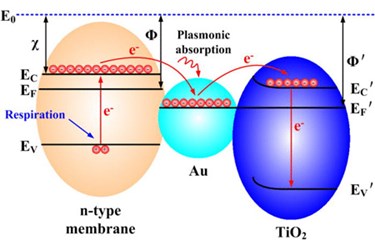Gold Nanoparticles Could Enable Antibacterial Implants
By Joel Lindsey

In a study conducted by researchers at the Shanghai Institute of Ceramics — part of the Chinese Academy of Sciences — scientists have devised a way to use gold nanoparticles as implantable antibacterial agents.
“Implant-associated infections have become a stubborn issue that often causes surgery failure,” Xuanyong Liu, lead researcher on the project, said in a press release issued recently. “Designing implants that can kill bacteria while supporting bone growth is an efficient way to enhance in vivo osteointegration.”
These tests were designed to solve the problem of implant-related infections, many of which occur when bacteria enters the body during surgery and then creates dangerous biofilms on the implanted devices or substances.
Previous research found that titanium dioxide is capable of killing bacteria because it acts as a photocatalyst. As the material is exposed to light, it absorbs photons and becomes a powerful electron acceptor that can disrupt the electron transport chain of bacteria — destabilizing the bacteria’s cellular membrane and causing the cell to die. But, since this process relies on the presence of light, it is ineffective for treating bacteria already growing inside a human body.
In this research project, scientists found that they could initiate a similar process by introducing gold nanoparticles.
When the gold nanoparticles interacted with titanium dioxide, they became energetically excited due to plasmon resonance — an interaction that occurs between dielectrics and conductors like gold and titanium dioxide. The excitation of the gold nanoparticles caused them to begin passing electrons to the titanium dioxide surface, effectively replicating the bacteria-killing process that occurs when titanium dioxide is exposed to light.
In the research team’s experiment, they created nanotube arrays of titanium dioxide applied with gold nanoparticles. They then allowed Staphylococcus aureus and Escherichia coli — both of which frequently lead to implant-associated infections — to grow on the arrays. The bacteria struggled to grow and exhibited significant cellular damage.
In addition to providing an effective way to destroy bacteria cells without relying on light, gold is also stable and generally biocompatible, making it a potentially safe and effective metal to use with implants, according to the press release.
“The findings may open up new insights for the better designing of noble metal nanoparticles-based antibacterial applications,” said Liu in the press release.
Results and details from the study have been published recently in the journal Applied Physics Letters.
Moving into the future, researchers plan to continue the project by expanding the range of bacteria tested against the nanoparticle substance and by evaluating the nanoparticles’ in vivo effectiveness in facilitating bone growth.
Image Credit: Appl. Phys. Lett. 104, 261110 (2014); http://dx.doi.org/10.1063/1.4885401
